Some plants filter toxins faster because they've developed specialized genetic adaptations and metabolic pathways that efficiently break down harmful compounds. You'll find these plants have larger leaf surface areas, denser foliage, and extensive root systems that work with beneficial microorganisms to accelerate toxin removal. Factors like bright indirect light, proper humidity, and ideal temperatures between 65-80°F enhance their filtering capabilities. Understanding these key differences can help you choose the most effective air-purifying plants.
Genetic Adaptations for Toxin Processing
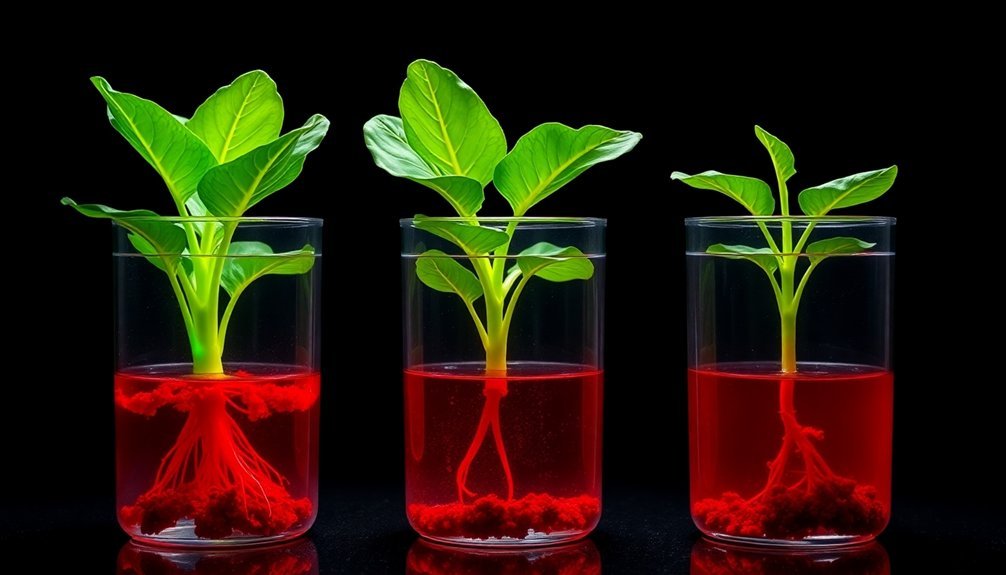
While many houseplants can absorb toxins from the air, some species have evolved remarkable genetic features that make them natural air purification powerhouses.
You'll find that these plants possess specialized metabolic pathways that efficiently process volatile organic compounds, breaking them down at accelerated rates.
These genetic adaptations enable enhanced enzyme production, allowing plants to target specific toxins like formaldehyde and benzene.
Plants' natural defense systems produce specialized enzymes that actively break down harmful indoor air pollutants into harmless compounds.
Plants with larger leaf surfaces are particularly effective, as their genetics optimize both photosynthesis and gas exchange.
Scientists have even developed genetically modified varieties, such as pothos plants, that express higher levels of toxin-degrading enzymes.
The plant's genetic makeup also influences how its roots interact with beneficial soil microbes, creating a thorough air purification system that works more effectively than standard varieties.
Leaf Surface Area and Absorption Rates
Surface area plays an essential role in determining how effectively plants filter indoor toxins.
You'll find that plants with larger leaf surface area can remove toxins from the air more efficiently due to their enhanced photosynthesis and gas exchange capabilities. When you're selecting plants for air purification, consider that a higher density of leaves per square meter directly correlates with better absorption rates.
While you might be tempted to choose a Boston fern based on lab results, you'll get better real-world performance from easier-to-maintain options like spider plants.
The key is finding plants that combine substantial leaf surface area with practical care requirements. Taller plants with extensive foliage typically demonstrate faster filtration rates, making them ideal choices for indoor air purification.
Look for species like Dracaena and Peace Lily that balance size with absorption efficiency.
Root System Architecture Impact

You'll notice that plants with dense, well-developed root systems excel at filtering toxins because they cover more soil area and interact with beneficial microorganisms.
Your plant's branching root patterns create an extensive underground network that maximizes contact with pollutants, enabling faster absorption and processing of harmful compounds.
The more extensive and complex your plant's root architecture is, the better it will perform at cleaning both soil and air pollutants through increased nutrient uptake and enhanced microbial partnerships.
Dense Roots Absorb More
Dense root systems provide a powerful advantage in toxin filtration, acting like an intricate underground network of natural filters.
When you're looking to improve air quality through plants, understanding how dense roots absorb toxins is essential.
Plants with extensive root networks excel at cleaning your environment through these key mechanisms:
- Increased surface area allows for maximum contact with soil contaminants
- Fibrous root systems outperform taproots in water and toxin absorption
- Mycorrhizal fungi partnerships enhance the root network's reach
- Complex branching patterns create more opportunities for toxin capture
- Root hair density directly impacts pollutant uptake efficiency
You'll find that plants with these dense root characteristics naturally filter more toxins from their environment.
This makes them particularly effective at improving both soil and air quality in your space.
Branching Patterns Speed Filtration
When it comes to toxin filtration, a plant's root branching pattern acts like nature's express highway system. You'll find that plants with complex branching patterns create an expansive network that speeds up their ability to filter toxins throughout the soil.
The more intricate a plant's root system architecture becomes, the better it'll perform at cleaning your environment.
Plants like Dracaena and peace lily showcase this perfectly – their elaborate root structures maximize contact with soil microorganisms, accelerating the breakdown of harmful compounds.
You're getting more efficient toxin removal because these branching patterns increase the surface area where helpful microbes can thrive.
Think of it as a vast underground web where each branch serves as an additional filtering station, working together to process pollutants faster and more effectively.
Microbiome Partnerships in Filtration
Your houseplants' toxin-filtering abilities depend heavily on the complex networks formed between their roots and beneficial soil microbes.
These microscopic partners work together with the plant's root system to break down and process harmful chemicals like formaldehyde and benzene more efficiently than the plant could manage alone.
When you maintain a healthy, diverse soil microbiome, you're actually supporting an entire ecosystem that greatly boosts your plants' air-purifying performance.
Root-Soil Microbial Networks
Beneath the surface of every successful toxin-filtering plant lies a complex network of microbial partnerships that supercharge its purification abilities.
Root-soil microbial networks can boost pollutant removal efficiency by up to 50%, transforming your plants into powerful air-cleaning machines.
When you're choosing plants for toxin filtration, consider these key factors about their underground partnerships:
- Bacteria and fungi form symbiotic relationships with roots
- Larger root systems host more extensive microbial communities
- Different plant species attract unique microbial populations
- Healthy soil microbiomes accelerate the breakdown of VOCs
- The rhizosphere acts as a natural toxin processing center
These microscopic helpers work tirelessly in the soil, breaking down harmful compounds while strengthening your plant's overall health and resilience.
The more robust the underground network, the more effective your plant's purification power becomes.
Plant-Bacteria Toxin Processing
Inside every thriving air-purifying plant, microscopic partnerships between roots and bacteria create a remarkable toxin-processing system. You'll find that plants with diverse root-associated microbiome communities process toxins more efficiently than those without these beneficial partnerships.
| Plant Feature | Microbial Impact | Filtration Result |
|---|---|---|
| Root Surface Area | Larger Bacterial Colony | Enhanced Toxin Breakdown |
| Bacterial Diversity | Improved Processing | Faster VOC Removal |
| Microbiome Health | Symbiotic Balance | Improved Air Quality |
The success of your plant's filtration abilities depends heavily on these invisible helpers. When you maintain favorable conditions for both the plant and its bacterial partners, you're supporting a complex system that breaks down harmful compounds more effectively. Plants like pothos and peace lily demonstrate this partnership particularly well, hosting specialized bacteria that accelerate the breakdown of airborne toxins.
Metabolic Pathways for VOC Breakdown
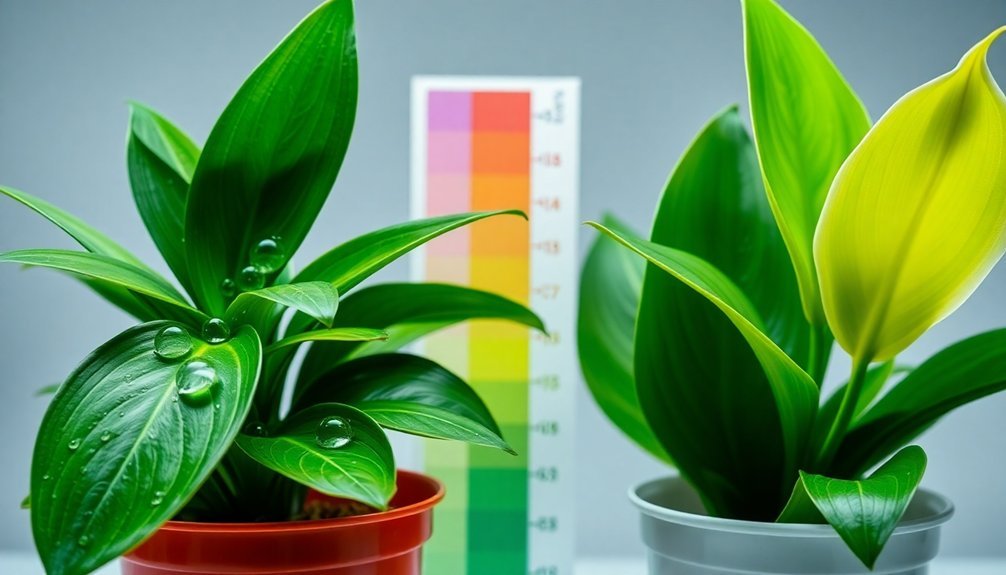
The remarkable ability of plants to break down volatile organic compounds (VOCs) relies on sophisticated metabolic pathways that vary between species.
You'll find that some plants are naturally better equipped for detoxification through specialized enzymes like cytochrome P450s, which transform harmful substances into harmless compounds.
Here's what makes certain plants more efficient at VOC breakdown:
- C3 and C4 metabolic pathways process toxins at different rates
- Higher transpiration rates allow for increased air filtration
- Specialized enzyme systems speed up the detoxification process
- Large leaf surface area enables greater toxin absorption
- Beneficial soil microorganisms assist in breaking down compounds
Understanding these pathways helps explain why plants like spider plants and peace lilies are particularly effective at cleaning your indoor air.
Their enhanced physiological features work together to create more efficient toxin-processing systems.
Plant Size and Purification Speed
When selecting plants for air purification, size matters considerably in determining filtration effectiveness.
You'll find that larger plants with extensive leaf surface area can process more toxins through photosynthesis, making them more efficient air cleaners. Plant size directly impacts indoor air quality, as bigger specimens have more substantial root systems that support beneficial microorganisms involved in breaking down pollutants.
For ideal toxin removal, you'll need at least two large plants per 100 square feet of space.
Species with bigger leaves and fuller foliage, like Dracaena and peace lily, work faster than their smaller counterparts. The volume of plant material – both above and below soil level – determines how quickly VOCs are filtered from your environment.
Simply put, when it comes to air purification, bigger plants deliver better results.
Light Requirements and Toxin Removal
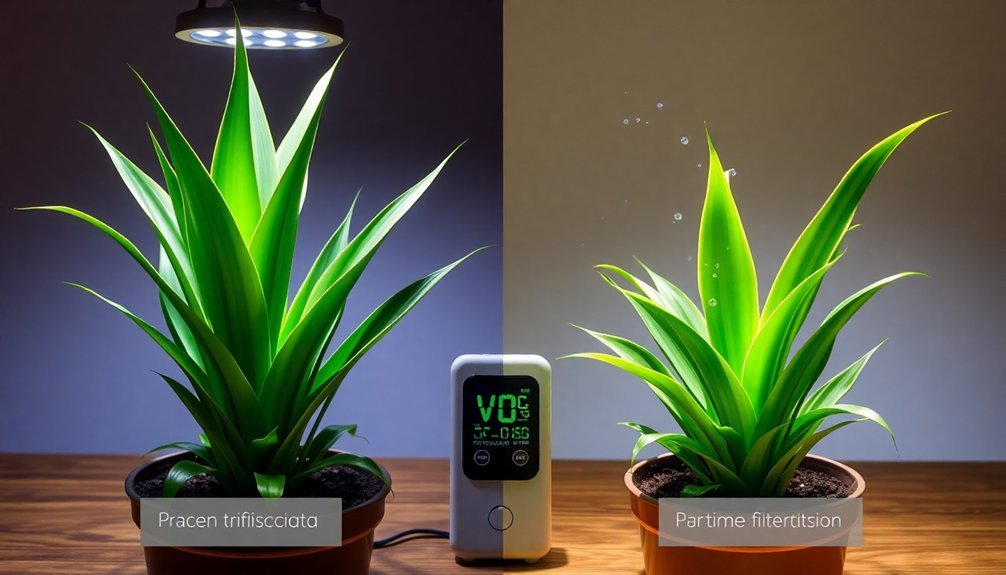
Since light directly fuels photosynthesis, proper illumination plays an essential role in your plants' ability to filter toxins effectively.
When you provide ideal light requirements for your indoor plants, they'll perform better at toxin removal and create a healthier environment for you.
Key benefits of proper lighting for your plants' air-cleaning abilities:
- Enhanced photosynthesis leads to more efficient conversion of CO2 to oxygen
- Better light exposure promotes larger leaf growth, increasing purification surface area
- Well-lit plants remove VOCs more effectively, as proven by NASA research
- Proper lighting supports healthier soil microorganisms that break down toxins
- Stronger metabolic activity in bright conditions speeds up the cleaning process
Remember that insufficient light will limit your plants' air-purifying potential, so positioning them in well-lit areas maximizes their toxin-filtering capabilities.
Environmental Factors Affecting Speed
Your plants' toxin-filtering abilities depend heavily on the amount of light they receive, with bright indirect sunlight typically speeding up the process through enhanced photosynthesis.
Temperature and humidity work together to influence how quickly your plants can process pollutants, as warmer temperatures combined with higher humidity levels boost the plants' metabolic rates and toxin absorption.
You'll notice faster filtration results when you maintain ideal environmental conditions, particularly by keeping humidity above 40% and ensuring consistent temperatures between 65-80°F (18-27°C).
Light Exposure Effects
Light exposure plays an essential role in how quickly plants filter toxins from your indoor air. Through photosynthesis, plants process and break down harmful compounds more effectively when they receive proper lighting.
You'll notice enhanced air purification results when you place your plants in bright, indirect light.
Key effects of proper light exposure on toxin filtration:
- Increases metabolic rates, boosting the plant's ability to absorb pollutants
- Activates larger leaf surface areas for more efficient VOC absorption
- Enhances photosynthetic efficiency, speeding up toxin breakdown
- Promotes overall plant health and growth for sustained filtering
- Maximizes the natural air-cleaning abilities of plants like Boston ferns and spider plants
Humidity and Temperature Impacts
Beyond proper lighting, humidity and temperature conditions greatly impact how effectively plants filter indoor toxins.
You'll notice better air purification results when you maintain humidity levels between 40% and 60%, as this range helps plants transpire more efficiently and absorb pollutants faster.
The temperature in your space also matters considerably. When you keep your environment consistently warm, you're helping your plants maintain ideal metabolic processes for toxin removal.
However, you'll want to avoid dramatic temperature swings, as these can stress your plants and slow down their filtering capabilities.
The relationship between humidity and temperature doesn't just affect the plants directly – it also influences the soil microorganisms that help break down absorbed toxins, creating a more effective cleaning system overall.
Species-Specific Defense Mechanisms
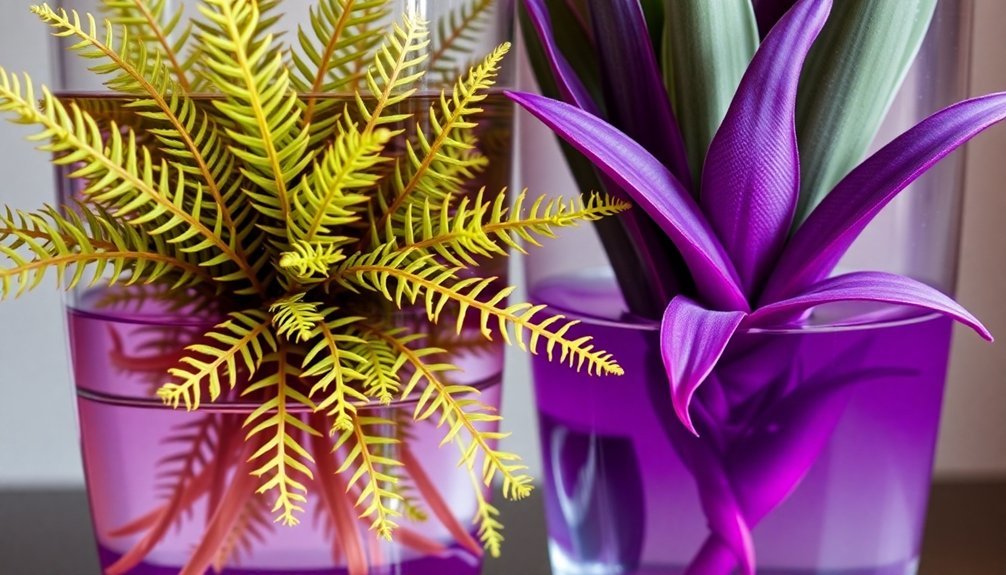
When it comes to filtering toxins from the environment, different plant species have developed remarkably distinct defense mechanisms.
You'll find that these species-specific defense mechanisms range from specialized enzymes to complex metabolic pathways for metabolizing volatile organic compounds.
Here's what makes certain plants better at filtering toxins:
- Plants like pothos excel at detoxification due to their robust root systems and partnerships with soil microorganisms.
- Spider plants leverage their large leaf surface area to filter toxins more quickly through increased gas exchange.
- Peace lilies can absorb toxins through both leaves and roots simultaneously.
- Some species have evolved specialized enzymes that break down specific pollutants.
- Symbiotic relationships with soil microorganisms boost certain plants' filtering capabilities.
These adaptations demonstrate nature's ingenious solutions to environmental challenges.
Cellular Structure Variations
The intricate cellular structures within plants serve as sophisticated filtration systems for environmental toxins. You'll find that plants with larger leaf surface areas and specialized stomata are particularly effective at filtering volatile organic compounds from the air you breathe.
When you examine a plant's cellular structure, you'll notice that chloroplasts and vacuoles work together to break down and neutralize harmful substances.
The thickness of cell walls makes a significant difference too – thinner walls allow toxins to diffuse more quickly into the plant's filtering system.
Some species have developed unique cellular mechanisms that enable them to process specific pollutants more efficiently. These adaptations include specialized enzymes and biochemical pathways that transform harmful compounds into harmless substances, making certain plants more effective at purifying your environment than others.
Enzyme Production and Efficiency
Since plants rely heavily on enzymatic processes, their ability to filter toxins largely depends on specialized enzyme production. You'll find that enzyme production varies greatly among different plant species, with some being more efficient at breaking down harmful compounds than others.
Key factors that influence toxin-filtering efficiency include:
- Specialized enzymes that convert VOCs into harmless substances
- Leaf surface area, which affects enzyme activity levels
- Natural enzyme concentrations, particularly high in plants like pothos
- Soil microbe interactions that enhance enzymatic breakdown
- Genetic factors that determine enzyme production capacity
These enzymatic variations explain why certain plants are superior air purifiers.
Scientists are now working on genetic modifications to boost enzyme production, which could create even more efficient toxin-filtering plants for your indoor spaces.
Plant Age and Filtration Capacity
Understanding plant age can dramatically affect your indoor air purification results.
You'll find that younger plants typically outperform their mature counterparts when it comes to filtering toxins from your air. Their higher metabolic rates and denser leaf structures enable them to process pollutants more efficiently.
When you're selecting plants for air filtration, consider that younger specimens often have more active root systems, supporting beneficial microorganisms that help break down harmful substances.
These plants adapt quickly to environmental changes, maximizing their filtration capacity in various indoor conditions.
While younger plants generally excel at toxin removal, you'll want to research specific species, as some maintain strong filtration abilities throughout their lifetime.
The key is balancing plant age with species selection to optimize your indoor air quality.
Seasonal Performance Differences
Just as plant age influences filtration effectiveness, seasonal changes greatly impact a plant's ability to remove toxins from indoor air.
You'll notice significant seasonal performance differences in your plants' filtration capabilities throughout the year, primarily due to environmental factors affecting photosynthesis rates and toxin absorption.
Key seasonal impacts on plant filtration:
- Spring and summer months boost metabolic activity, enhancing toxin removal
- Warmer temperatures increase photosynthetic efficiency and leaf surface area
- Shorter days and colder temperatures in winter reduce filtration effectiveness
- Soil microbial activity peaks during warm, humid conditions
- Plants like spider plant and pothos show superior filtration in growing seasons
Understanding these seasonal variations can help you maximize your plants' air-purifying potential by providing ideal growing conditions year-round.
Frequently Asked Questions
What Plant Removes the Most Toxins?
You'll find the golden pothos removes the most diverse range of toxins. It's highly effective at filtering formaldehyde, benzene, and other VOCs, while being easy to maintain in your indoor environment.
Do Air-Purifying Plants Actually Work?
While plants can filter some toxins, they won't greatly purify your home's air. You'd need hundreds of plants per square meter to match lab results. It's better to rely on proper ventilation and air purifiers.
How Do Plants Filter Toxins?
Plants filter toxins through their leaves and roots by absorbing harmful compounds into their tissues. You'll find they work with soil microbes to break down these toxins through a natural process called phytoremediation.
What Plant Removes 78% of Airborne Mold?
You'll find that the peace lily effectively removes 78% of airborne mold spores within 24 hours. It's a powerful air purifier that also filters out formaldehyde, benzene, and other common indoor pollutants.
In Summary
You'll find that plants with enhanced toxin filtration possess specific genetic advantages, specialized enzyme systems, and well-developed root networks. When you're selecting plants for air purification, consider those with larger leaf surface areas and established microbiome partnerships. Remember that a plant's age, seasonal cycles, and metabolic efficiency all play essential roles in how quickly it can process and neutralize harmful compounds.

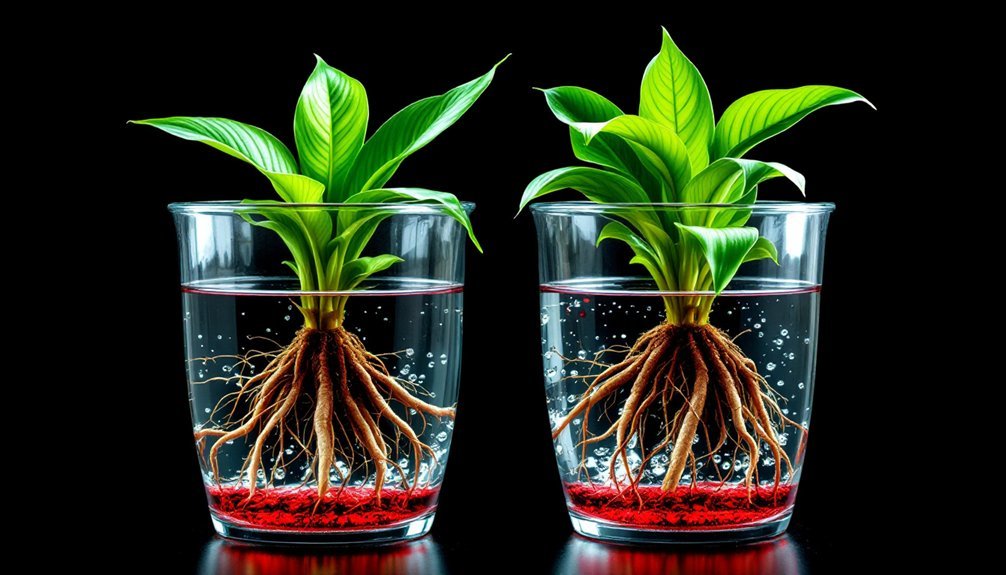



Leave a Reply